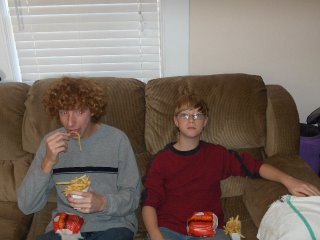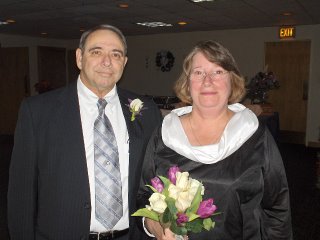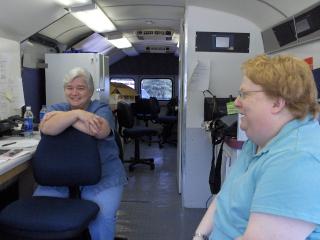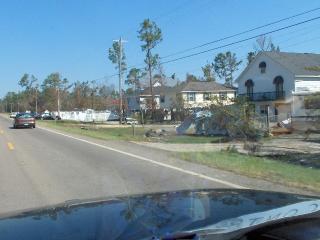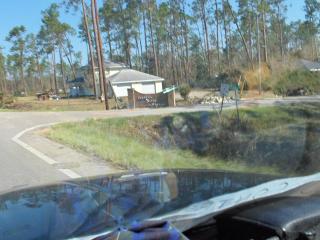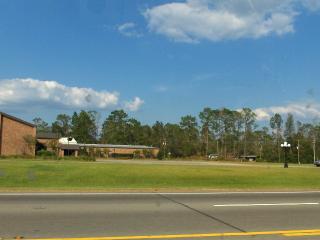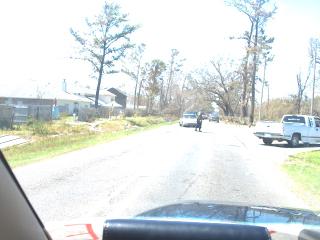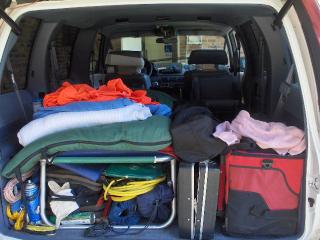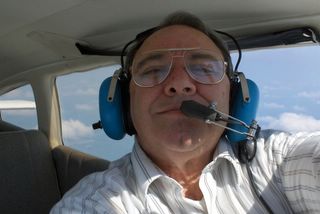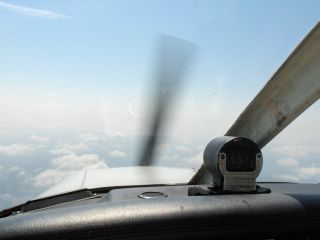One of our readers made the comment some time ago that he wanted to hear more about flying. Here we go, my last trip, made last month,
Bobby had left 44355 out of the hangar, under the lights next to the terminal, as I had told him I was going to leave before daylight. Since night flying is inherently more dangerous than flying in daylight, I have developed a habit over the years of doing an especially thorough preflight if I'm going to be up there when the sun isn't shining on my plane. So, at 4:30 am, I was out on the ramp, going over Cherokee 44355 with my fine-tooth comb. It was especially humid that morning, so it took a lot of toweling to get the windscreen clear enough to see out of. That done, a good look inside the engine compartment.
We have a relatively new engine in the plane, it had at the time about 25 hours on it, so that alone takes a close look. The good thing is, after about 10 hours if nothing quits, it's probably not going to. I was a bit surprised that it started a lot easier than I was accustomed to, and idled a lot smoother than the old engine did. Idling the engine, I started out for the end of the runway, checking avionics and instruments as I taxiied down to the end of runway 24, the one most aligned to my route of departure.
The destination was Columbus, Georgia, a distance according to the charts, of 133 miles, about one hour and ten minutes flying time, at a compass heading of about 280 degrees. Nice, easy route, no difficult places to traverse. There was one restricted area around Warner Robins AFB, to my right, north, and one restricted area to my left, Fort Benning, as I approached Columbus.
Engine runup showed all gages in the green, everything working normally, and I was ready to go. Aligning on the runway, I "poured the coal" to it, and the 160hp Lycoming pushed us rapidly toward the rotation speed of 60 knots. When the airspeed indicator shows 60, you just ease back on the yoke and hold it there, and when it hits 70, the plane somewhat magically lifts off and heads into the "wild blue - er, strike that, -
black yonder". It always feels like magic to me, even with a lot of years and a lot of hours of flying. It never gets old, and I never get tired of flying, just gets more enjoyable every time I get to go flying. That opportunity is less than ever as of late, as I'm living on just my miniscule retirement and my wife's nursing salary. I'd love to work at anything that comes up, but that just isn't happening right now, there seems to be no open jobs around our small town. When I do find one, the flying is gonna be back up there!
Back to the early morning flight -- as the plane lifted off the runway, I maintained runway heading, 240 degrees, as we gained altitude. Although I knew it was black dark, it was a little surprising just how few lights were visible on the ground. Right away I was on the gages, no horizon visible, few lights, and a big dark hole that we were flying into. No problem, with all my experience, I have done a lot of night flying and have always loved it. Flying at night, the lights are pretty, the sky is majestic, and it is just really enjoyable. At around 1,000 feet altitude, I turned right to course 280, centering up the GPS, showing 130 miles to go. I love GPS, it's the best thing since enclosed cockpits!
Staying on instruments, I started a cruise-climb to 6500 feet, above the low-hanging scud, and under a bright, starlit sky. It was just beautiful! Before reaching altitude, about five minutes after departure, we contacted Jacksonville Center, the controlling radar control center for our area. Although a flight under VFR, visual flight rules, doesn't require contact with anyone, I always get in touch and under control, because it's safer that way. That means I have someone on the ground watching after me, keeping me informed of any traffic that might conflict with me, letting me know if any weather is developing ahead of me.
"Jacksonville Center, cherokee 44355," I spoke,
"Cherokee 44355, Jacksonville center, go ahead," came the reply.
"We're off from Vidalia about five minutes ago, squawking VFR, would like flight following."
"44355, squawk 3265," came the reply, giving me a code to dial in on my transponder. The transponder, which responds when it is hit by a radar pulse, gives positive identification to the aircraft's return on the radar screen in front of the controller. Without the transponder, the controller doesn't have a very good radar return, but with the boosted signal from the transponder, they have a much better look at the aircraft. Being VFR, the controller doesn't give us an assigned altitude while in uncontrolled airspace, and the transponder includes altitude information in its reply. On we went, boring a hole in the night sky, keeping a watch outside for any flashing lights that would indicate the presence of traffic.
It was a smooth, uneventful flight, no surprises, and really enjoyable. About an hour later, descending to a lower altitude, and under control of Atlanta Approach, we got ready to land at CSG, Columbus airport. Day had dawned, bringing blue skies overhead, and a good view of the ground below. Approach had kept me clear of any restricted airspace, and about ten miles out, we had the field in sight. Once I mentioned that fact to the approach controller, he authorized a frequency change to the tower frequency, where we received landing clearance.
Reducing power, I brought the speed down to less than 100 knots, where I could drop flaps. On the downwind leg, parallel to the runway, I dropped the first notch of flaps, which allowed a nose-down attitude, and then turned base, which is perpendicular to the runway. Another notch of flaps, reducing power to 1600 RPM, we started down to around 800 feet, and turned final with about 500 feet. Seeing that I was a bit high, I put in all the flaps and pushed the nose over for a steep approach, rounding out right over the end of the runway. With a short "squeak," the tires touches, and we were down. Another nice flight was over, and it was off to the doctor's office a few blocks from the airport for my doctor's appointment. Returning later in the day will be our next adventure in flying.
